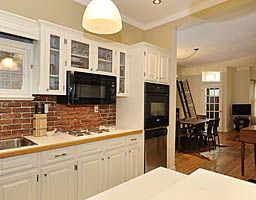This week’s House Crush is located in the Rosedale of yesteryear – South Parkdale.
Once upon a time, South Parkdale was Toronto’s most luxe neighborhood, with stunning architecture and moneybags residents to match. However, when post WWII housing conversions encouraged an influx of working-class people to the neighborhood, and lake access was cut off by construction of the Gardiner Expressway in 1955, property values started to wane and many of Parkdale’s upper-crust denizens left for greener pastures.

Puttin' on the ritz! Built the 1890's, this Parkdale manse features a turret topped with a conical roof, a dollhouse-style gable, and Romanesque arches.

Stylin' green gables a la Lucy Maud Montgomery. The timber on the gables reflects the English cottage style that was hip back in the day.
The construction of various high-rise apartment buildings and social housing in the ’60’s damaged property values even further and the remaining mansions of South Parkdale fell largely into disrepair and many became divided into illegal boarding houses.

High-rise apartment buildings line the streets of Jameson Avenue. Often poorly maintained, residents are forced to live with mice, cockroaches, bedbugs and non-functioning appliances. The Parkdale Residents Association awards the Golden Cockroach trophy to the worst landlord in Parkdale and the Bedbug Registry's map of Toronto is lit up like a Christmas tree with infected buildings in South Parkdale.
The population of Parkdale went through another change with the deinstitutionalization of psychiatric care in Canada in the ’70’s and ’80’s. Due to its close proximity to the Queen Street Centre for Addictions and Mental Health, the largest facility of its kind in Canada at the time, thousands of psychiatric patients were discharged at once and most took up residency in South Parkdale. With a severe lack of community care facilities or supervised group homes for these patients, many gravitated towards illegal boarding houses. South Parkdale became known as a ‘service-dependent ghetto’, where former mental patients were seen as insane, dangerous transients rather than people in need.
Why did this neglected corner of Toronto start to make steps towards gentrification in the ’90’s? In The New Middle Class and the Remaking of the Central City, David Ley says that “low-income areas will be entered [by the middle class] if they hold some specific asset such as affordability, a distinctive housing stock, a particular lifestyle ambience, or proximity to downtown and its varied services…. In the Canadian inner cities, a distinctive period architecture is a common feature of the gentrifying inner neighbourhood.”
Check, check, check.
At $449,000, this renovated Victorian charmer is well-priced for the area but the trade-off is being a few houses in from Queen Street and the train tracks. The hop, skip and a jump proximity to the Parkdale Community Health Centre can be seen as either a blessing or a curse depending on the buyer’s point of view. Some residents appreciate the health services and community programming on offer, others may not like being a few doors down from a needle exchange program. However, one would assume that if you’re shopping in Parkdale, you are well aware of the neighborhood’s “unique flavour”.
Based on the selling price of $565,000, or 126% of list, it’s safe to say that most buyers didn’t find the location problematic.
Since you’ve endured the history lesson so patiently, I’ll move on to the house porn:
The kitchen in this house seems like a warm and fuzzy place to enjoy a home-cooked meal or cup of Earl Grey. The exposed brick and great views to the garden are icing on the cake. Original wood floors give the house a vintage vibe that most buyers would appreciate.
The deets:
Queen/Dufferin, Attached, 2-Storey, 3 bedrooms, 2 bathrooms
List: $449,900
Sold: $565,000 (126% of list, April 2010)
Taxes: $2,724
Lot: 16 x 97 Feet
Parking: 1 space
Remarks For Clients: Charming Victorian Row House On One Of Parkdale’s Prettiest Streets. 3 Bdrms, 2 Full Bathrms. Bright Reno’d Kitchen W/ Ceramic Flrs, Exposed Brick And Walk Out To Huge Deck. Backyard Features Lrg Storage Shed & Retractable Gate For Additional Prkg. Renovated Basement With Separate Entrance. Potential For Bsmt Apt. Close To Shops, Cafes, Galleries And Liberty Village.
To learn more about the history of Parkdale, please check out:
Toronto’s South Parkdale Neighbourhood, A Brief History of Development, Disinvestment, and Gentrification by Tom Slater








